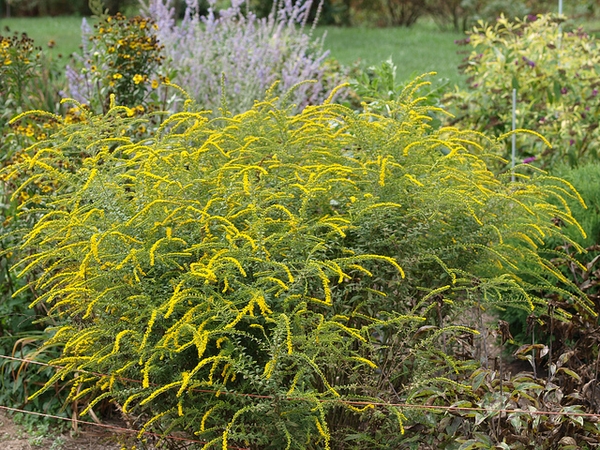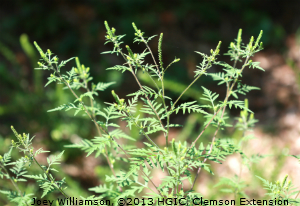Goldenrod: Not the Reason for Our Sneezin’
By Pat Dickey, Fairfax Master Gardener
 Bright yellow varieties of goldenrod (Solidago spp.) in the local fields and gardens have been blamed for the allergies that many of us have during this time of year. Nothing could be further from the truth.
Bright yellow varieties of goldenrod (Solidago spp.) in the local fields and gardens have been blamed for the allergies that many of us have during this time of year. Nothing could be further from the truth.
Goldenrod is not wind pollinated. Insects are attracted to its flowers for their nectar, which are an important food source for them in the fall season until the hard frost. A single flower cluster of goldenrod has hundreds of tiny flowers. Bees, butterflies and many insects that target pests will come to feed on these flowers and then carry away the sticky pollen.
Since there are fewer insects still active during in the fall, goldenrod struggles to find other ways to reproduce besides pollination. One way is by producing thousands of wind-borne seeds that will hopefully germinate next summer. Another way is by sending out off-shoots with underground rhizomes. These methods of reproduction will help the goldenrod to come back the following year, despite the cold winter or drought conditions.
There are many types of goldenrod with varying shapes of flower clusters and leaves, including wands, clubs or plumes. Over 100 species have been documented, many of them being native plants. They usually favor lightly-shaded woodlands, but some varieties will thrive in full sun.

Solidago rugosa
Many other types of goldenrods are suggested for home gardens and other wildflower settings by the Plant Northern Virginia Natives Campaign. You may be able to purchase them from local native plant sales. One notable species is the blue-stemmed goldenrod, S. caesia. It grows from 1 to 3 ½ feet and does well in a lightly-shaded setting with dry or well-drained soil. Its arching greenish-purple stems hold tiny yellow daisy-like flowers. Another goldenrod for our area is S. altissima, tall or late goldenrod. It does well in full sun and grows to 6 feet in moist or dry soil. Its yellow flowers form a plume-like feathery appearance.

Ragweed
The next time you drive by an area with beautiful yellow goldenrod swaying in the breeze, remember that this is a beneficial native plant to enjoy and appreciate.
References
Native Plants for Northern Virginia, Plant Northern Virginia Natives Campaign
aaah-CHOO (The real culprit), National Park Service, Delaware Water Gap, National Recreation Area, 2011